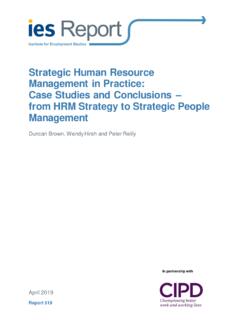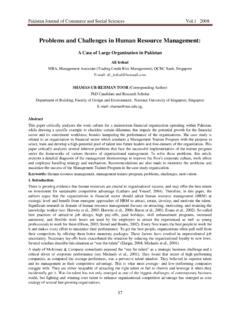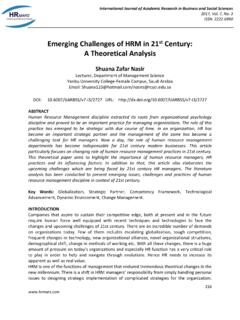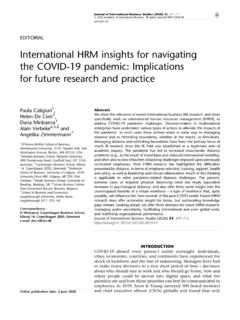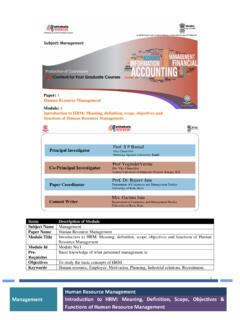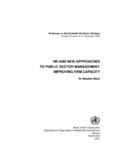Transcription of The Impact of Human Resource Management Practices on ...
1 The Impact of Human Resource Management Practices on Employees Satisfaction: A Field Study in the Jordanian Telecommunication Companies. : . Prepared By: Nooraldeen A. AlShaikhly Supervised By: Dr. Asmhan AlTaher Thesis Submitted in Partial Fulfillment of the Requirements for Master Degree in Business Administration. Business Administration Department Faculty of Business Middle East University June 2017 II III IV V ACKNOWLEDGEMENT First and foremost, I would like to begin with thanking Allah the Almighty, for whom I owe what I have achieved so far. I would like to express my heartfelt gratitude towards the people whom I respect for their assistance, support, and encouragement in so many ways during my study. I begin with my supervisor, Dr. Asmhan Al-Taher for the useful comments, remarks and engagement through the learning process of this master thesis.
2 I also thank my supportive family for their patience, compassion, and guidance. I would not have been what I am now without having such an incredible family support and encouragement to be a better person I m forever grateful for your love. Moreover, I will never forget to thank my true friends who have been there for helping me along the way till this work was finally done. To those people, I dedicate this thesis with acknowledgement and pride. Sincerely Yours, VI DEDICATION I dedicate this thesis to my beloved family who raised me to be a better person, and always will be there for me. VII Table of Content Contents Cover I Authorization .. II DISSCUSSION OF COMMITTEE DECISION .. III .. IV ACKNOWLEDGEMENT .. V DEDICATION .. VI List of Tables .. IX List of Figures .. X ABSTRACT .. XI .. XIII Chapter One: General Framework .. 1 Introduction.
3 2 Study Problem .. 4 Objectives of the Study .. 5 Significance of the study .. 5 Study Questions & Hypotheses .. 6 The Study Model .. 8 Study Limitations .. 8 Study Delimitations .. 9 Study Terminologies .. 10 Chapter Two: Theoretical Framework & Previous Studies .. 12 Introduction .. 13 Human Resource Management (HRM) .. 13 Planning and Recruitment .. 17 Compensation .. 20 Training Programs .. 22 VIII Performance Appraisal .. 24 Employees satisfaction .. 28 Previous Studies .. 31 Study Contribution to knowledge .. 41 Chapter Three: Methods and Procedures .. 42 Introduction .. 43 Study Methodology .. 43 Study Population and 43 The Study Tool and Data Collection .. 45 Study Approach .. 46 Statistical Treatment .. 47 Validity and Reliability .. 48 Chapter Four: Results and Hypotheses Testing .. 51 Introduction .. 52 Respondents Demographic Description.
4 52 Normality Test .. 55 Descriptive Analysis of Study Variables .. 56 Multi-Collinearity Diagnostics .. 62 Study Hypotheses Tests .. 63 Chapter Five: Conclusion & Recommendations .. 69 Introduction .. 70 Study Results .. 70 Study Conclusions .. 72 Study Recommendations .. 73 References .. 75 Appendices .. 844 Appendix (1): English Survey .. 855 Appendix (2): The Academic Arbitrators .. 911 IX List of Tables Chapter-Table Contents Page (3-1) Distributed questionnaires on Mid & Low level employees in Jordanian telecom companies 45 (3-2) Human Resources Management Practices Items 46 (3-3) Reliability analysis of the study scales 50 (4-1) Demographic Analysis 54 (4-2) Normal Distribution of Study Variables 55 (4-3) Descriptive statistics of Planning and Recruitment 56 (4-4) Descriptive statistics of Training Programs 57 (4-5) Descriptive statistics of Compensation 58 (4-6) Descriptive statistics of Performance Appraisal 60 (4-7) Descriptive statistics of Employees satisfaction 61 (4-8) Results of Variance Inflation Factor and Tolerance 63 (4-9) Main Hypothesis Test 64 (4-10) First Sub-Hypothesis Test 65 (4-11) Table (4-11): Second sub-hypothesis test 66 (4-12) Third sub-hypothesis Test 67 (4-13) fourth hypothesis test 68 X List of Figures No.
5 Contents Page (1) The Study Model 8 XI The Impact of Human Resource Management Practices on Employees Satisfaction: A Field Study in Jordanian Telecommunication Companies Prepared by Nooraldeen A. AlShaikhly Supervised By: Dr. Asmhan AlTaher ABSTRACT This field study aimed to investigate the Impact of Human Resource Management Practices on employees satisfaction in Jordanian telecommunication companies. The study domain consisted of the three existing Jordanian telecommunications companies (Orange, Umniah and Zain). The population consisted of 1400 mid-level and low-level employees. The stratified randomized study sample consisted of 302 employees. To reach the purpose of this study, data were collected from 202 out of 302 employees by using the questionnaire. The questionnaire was developed and refined by literature review and panel of referees committee.
6 Statistical techniques such as descriptive statistics, Skewness and Kurtosis test, Cronbachs alpha and simple regressions were used to test the study hypotheses. And after testing and analyzing the study hypotheses, the results showed There is a significant Impact of Human Resource Management Practices (Planning & recruitment, training programs, compensation and performance appraisal) on employees satisfaction in Jordanian telecommunication companies at level ( ). The results also showed that the compensation variable has the most Impact on employees satisfaction. XII The study recommended to the top Management in telecommunication companies the need to improve their support for the use of Human Resource Management , and to enhance the consultation of experiences to build a strong HRM system. And the need to be more transparent with their recruitment process to the current and potential employees, and to work on the quality of training that the telecommunication companies provide to their employees and include them in the building process of these program in order to implement programs that increase their thinking and analysis skills, and recommended the top Management to implement a more fair incentives system that provides the employees with the benefits they need other than the basic ones, like health care and other non-cash benefits.
7 And to be more aware of their employee opinions by having an open door policy to their lower-level employees, and to provide constant feedback thus implementing a more fair and honest evaluation system that demands realistic expectation from employees and to empower their employees by giving employees the chance to tryout their learned skills on the giving jobs, and to help them set realistic goals for performing their work as a result of their training. Keywords: Human Resource Management Practices , Planning & Recruitment, Training Programs, Compensation, Performance Appraisal, Employees Satisfaction, Jordanian Telecommunication Companies. XIII : . : : .. ( ).
8 0011 . 213 . 313 213. , . ( ) XIV ( .) . " ".
9 : .1 Chapter One: General Framework ( ): Introduction ( ): Study Problem ( ): Objectives of the Study ( ): Significance of the Study ( ): Study Questions & Hypotheses ( ): The Study Model ( ): Study Limitations ( ): Study Delimitations ( ): Study Terminologies 2 Introduction: In today s world of business, global competition is the basic element that concerns the minds of CEOs and researchers and as a result to this, industrial economy has been experienced to pass toward to knowledge economy. In the last two decades All researchers and practitioners efforts have mostly focused on Human Resource Management (HRM) Practices , considering the employee perceived emotion, the state of wellbeing and job satisfaction is a high priority for top managers and HR managers, knowing that Human capital is the most essential part of any firm, and organizational goals can be achieved through them.
10 The field of Human Resource Management (HRM) has travelled a long way from its simple personnel Management where the job of the personnel manager was only concerned with job vacancies, recruitment, tracking employee payrolls, promotions and other mundane personnel issues. Human resources Management (HRM) is a term used to represent that part of an organization s activities concerned with the recruitment, development and Management of its employees (Wood & Wall, 2002). The modern field of today s Human Resource Management (HRM) is attracting a great deal of attention because of its potential Impact on organization s survival and prosperity. There is now an evolving belief that, if organizations wish to survive and compete in today s talent-based global economy, they have to acquire, develop, and accordingly manage world-class Human Resource Management competencies and Practices .
